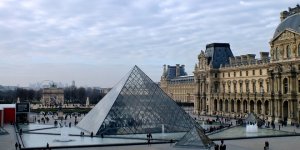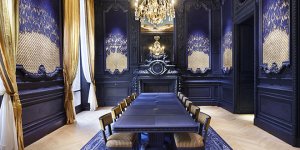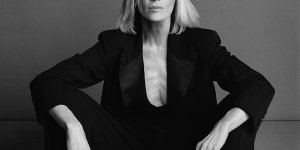Pierre and Gilles Champion Environmental Conservation in Their All-New Motionless Wanderings Exhibition
The French artist duo Pierre and Gilles, known for their dreamy, magical and mysterious portraits combining photography and painting, exhibit their latest creations at Galerie Templon in Paris.

Pierre et Gilles, Le vendeur de tous Eiffel (Ibrahima Ramon Magassa), 2019 Œuvre unique photographie imprimée par jet d’encre sur toile et peinte / Ink-jet photograph printed on canvas and painted 105,5 x 133,5 cm ; 41 1/2 x 52 1/2 in.
For over four decades, photographer Pierre Commoy and painter Gilles Blanchard have been developing hybrid, four-hand images that are half-photo and half-painting, and have today established themselves in the history of Western portraiture. At the crossroads of reality and fantasy, their extravagantly-staged works are nourished by multiple references from Greek mythology and religious idols to baroque art and Hindu iconography. Madonna, Jean-Paul Gaultier, Kylie Minogue, Dita von Teese, Rose McGowan, Isabelle Huppert and Catherine Deneuve – the most emblematic stars of their time have all come under the lens of Pierre, 70, and the brushstrokes of Gilles, 67, who retouches and embellishes each photo, applying real paint to canvas, thereby having invented Photoshop without a computer before digital editing even existed.
Pierre and Gilles Champion Environmental Conservation in Their All-New Motionless Wanderings Exhibition

Pierre et Gilles, Le petit bizut (Vincent Cohen), 2018 Œuvre unique photographie imprimée par jet d’encre sur toile et peinte / Ink-jet photograph printed on canvas and painted 126,5 x 88,5 cm ; 49 3/4 x 34 7/8 in.
Working according to an original modus operandi, each of their creations is a unique piece. They have their models – friends, celebrities and strangers – pose in sophisticated decors that can take up to 10 days to handcraft from A to Z, using the objects they have on hand or that they source, after having made pencil drawings on paper. Once the photo has been taken and digitally printed on canvas, then begins the long painting process to refine and sublimate the image, executed on an easel on the ground floor of their apartment under a light-filled glass roof. Pierre explains why they’ve gone digital: “We shoot digitally, no longer on film. With digital, we can see the screen and control the photography in real time. Digital technology allows us to collaborate directly with the model. Working in film had become complicated because the material is not as readily available as it used to be – you have to order online. After taking the photo, we then work on the colours, the printing and the hand-painting. So we are not against modernity: we live in our time, and we like to combine modern and old techniques.”

Pierre et Gilles, La pêche miraculeuse (Pierre et Filip), 2019 Œuvre unique Photographie imprimée par jet d’encre sur toile et peinte / Ink-jet photograph printed on canvas and painted 127 x 147 cm ; 50 x 57 7/8
The real-life couple has been inseparable ever since their first fateful meeting in 1976 at the opening party of a Kenzo boutique in Paris. After several months of living together, they decided to create images jointly, with their first series being of their friends making faces on vibrantly-coloured backgrounds, inspired by photo booths. Disappointed by the results, Gilles then started to paint them. In the 1980s, they were regulars at Le Palace, Bus Palladium and Le Sept, nightclubs frequented by the gay crowd, fashion royalty and pop stars, thus stumbling upon their models by chance, just by going out. Everything happened naturally through encounters, friendships and a desire to work with one another. They alternated between commissioned work – making images for the gay press and music album covers – and personal pieces, and never had to call a particular actor or singer to pose for them. In fact, it was their famous portrait of French singer and songwriter Étienne Daho in a white-and-navy blue striped sailor shirt with a parakeet on his shoulder that they made for his album La Notte, La Notte in 1984 that truly launched their career. Today, artists and even strangers contact them via social media to serve as their models, or they reach out to them themselves. Fascinated by strong characters, by originality and difference instead of beauty, by people who are magnificent in a strange, new and surprising way, they’re interested as much in the personality of their model as the image they project.

Pierre et Gilles, La reine des océans (Adèle Farine), 2020 Œuvre unique photographie imprimée par jet d’encre sur toile et peinte/ Ink-jet photograph printed on canvas and painted 145 x 104 cm ; 57 1/8 x 41 in.
Immediately recognisable, Pierre and Gilles’ universe overflows with artificial flowers, streamers, cotton clouds, fake stars, birds, Christmas baubles, talismans, trinkets, toys, crowns and halos of light. Straddling the secular and the sacred, lightness and melancholy, their kitsch works filled with saturated colours evoke emotions and dreams. Drawing inspiration from their childhood, film, music, funfairs, starry skies, fairies and saints, they have a singular aesthetic exploring the frontiers between art history and pop culture. Fond of referencing other artists in their works like Bernard Buffet, Gustave Courbet, Édouard Manet and Rembrandt, Gilles says, “Generally speaking, we are very fond of ancient and modern art. We like to discover new references: the artists we liked young are not necessarily the ones we like today. We find new references in books or on the Internet. When we work, we don’t necessarily think of classical masters in particular. The inspiration is quite natural, not exactly sought after. For us, what is beautiful in art is what eludes us. We’re not looking to highlight specific allusions – we also like what isn’t calculated or obvious.”

Always having worked from home, Pierre and Gilles’ compositions gained in complexity and sophistication over time. Starting in a small studio where they could only make stylised, close-up portraits on monochrome backdrops recalling the pop art aesthetic of Andy Warhol’s serigraphs, they then moved to a larger apartment in Bastille, where they built entire sets by hand, superimposing foregrounds and backgrounds. Speaking of the artisanal nature of their work, even the picture frame for the final artwork is conceived by the artists themselves. Today, their images come to life in their 60-sqm atelier located in the basement of their duplex in Le Pré-Saint-Gervais in the Parisian suburbs, replete with a small stage, projectors, models and boxes of accessories. They work non-stop, as making an image takes time. Requiring between 15 days and three weeks to finish a portrait, they produce 12 to 15 per year. Their creations tell their story and illustrate an entire era, with each model incarnating a role, playing another character than their own. There’s something eternal in their works, as they metamorphose their subjects into sacred and sublime creatures, immortalised for all time.
While not hardcore militants at heart, Pierre and Gilles express their social and ecological engagement and messages of commitment to freedom and tolerance subtly through their works, tackling subjects such as identity, sexuality, politics, religion and immigration, including the Arab Spring and Marriage for All movements. Keen observers of society and its ills, their activism is not overt in their art, but reveals itself as an undercurrent. Their Les Naufragés series of sleeping young men spoke of the AIDS crisis that had claimed the lives of many artists. “The news has always been present in our work, which has evolved over time, depending on the contradictions of our world,” comments Pierre. “At the beginning, our vision was more positive: we talked about happiness, beautiful things, dreams, while drawing inspiration from popular culture. The older we get, the darker and darker we find the world. The AIDS epidemic in the 1980s transformed us a lot; our work has become deeper. This is why it’s important for us to be artists, to respond to this harshness: we try to see the world in a better light. For us, art keeps the world moving.”

Pierre et Gilles, Bonjour Pierre et Gilles, 2020 Œuvre unique photographie imprimée par jet d’encre sur toile et peinte/ Ink-jet photograph printed on canvas and painted. 163 x 114 cm ; 64 1/8 x 44 7/8 in.
In their upcoming Motionless Wanderings exhibition at Galerie Templon in Paris from 10 September to 24 October 2020, Pierre and Gilles will be presenting works created over the past two years, many never seen before. It opens with a self-portrait they had completed during the Covid-19 lockdown in France, Bonjour Pierre et Gilles, which pays homage to Gustave Courbet’s painting Bonjour Monsieur Courbet, showing the couple walking on a path amidst housing estates and residential suburbs disguised as thugs, scrap metal dealers, homeless people or Yellow Vest protesters. There’s also an African immigrant, easily recognisable as a street-seller of miniature Eiffel Towers, and a young man dressed in a trash bag scribbled with swear words and carrying a doll. Calling attention to environmental protection, specifically to the damage humans are causing to the oceans through large amounts of plastic and textile pollution, they’ve crafted imaginary and troubling scenes of marine iconography and aquatic mythology from debris and litter collected from the beaches of Le Havre, such as a motionless couple entangled in fishnets and a sea deity reigning majestically in her underwater kingdom. Both from coastal regions – Gilles from Le Havre and Pierre from La Vendée – and yearning from young to escape from the boredom of their provincial towns, the sea has always held special importance in their life and work. “It’s a universe that inspires us,” Gilles remarks. “We worked on portraits that depicted sailors and castaways in the 1980s. Here, we therefore collected old ropes, nets, plastic objects on the beaches. It may seem surprising, but we have always liked plastic – we find it beautiful. We gather it from behind the cliffs of beaches like picking flowers, for fun. We keep it in stock in our atelier. We also buy plastic objects for our sets. For us, it’s possible to discover the world through cheap junk.”
By Nina Starr. All images are courtesy of PIERRE & GILLES.







